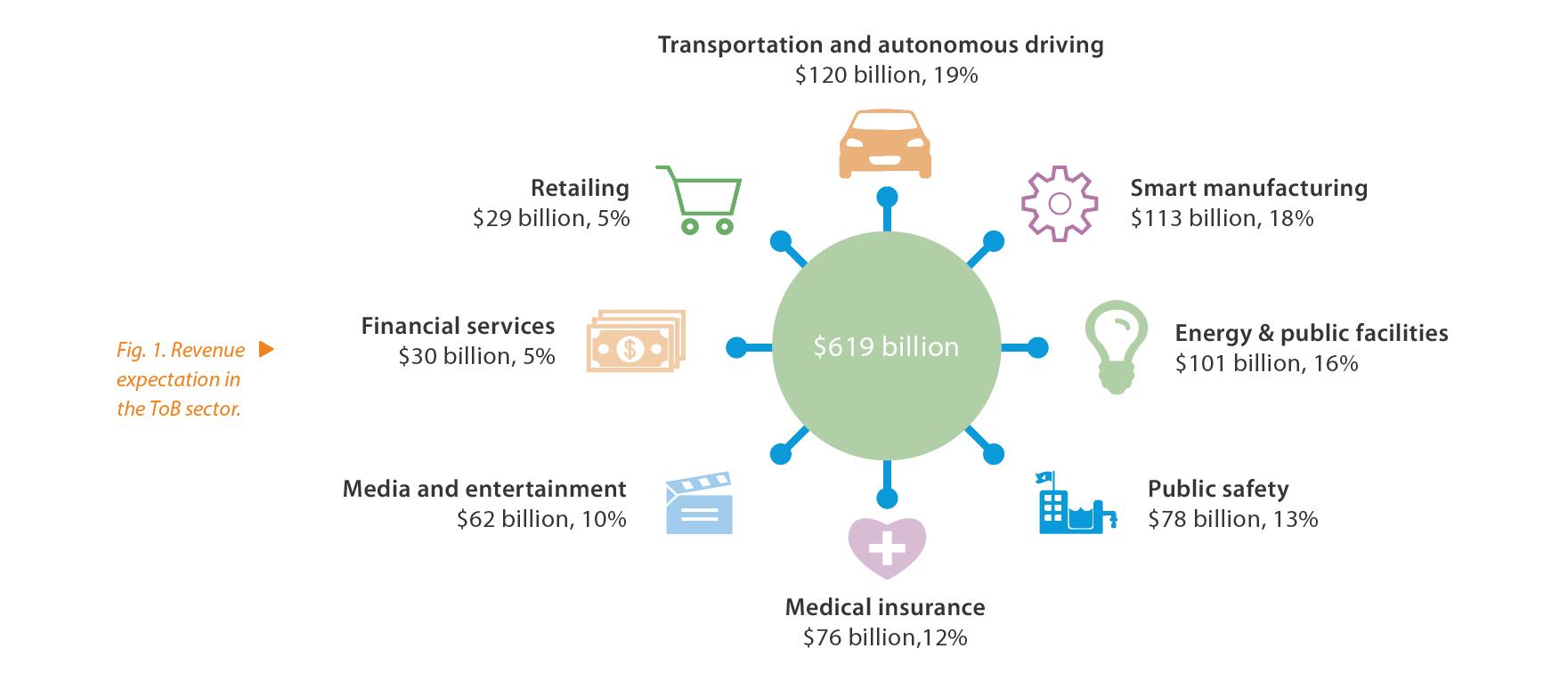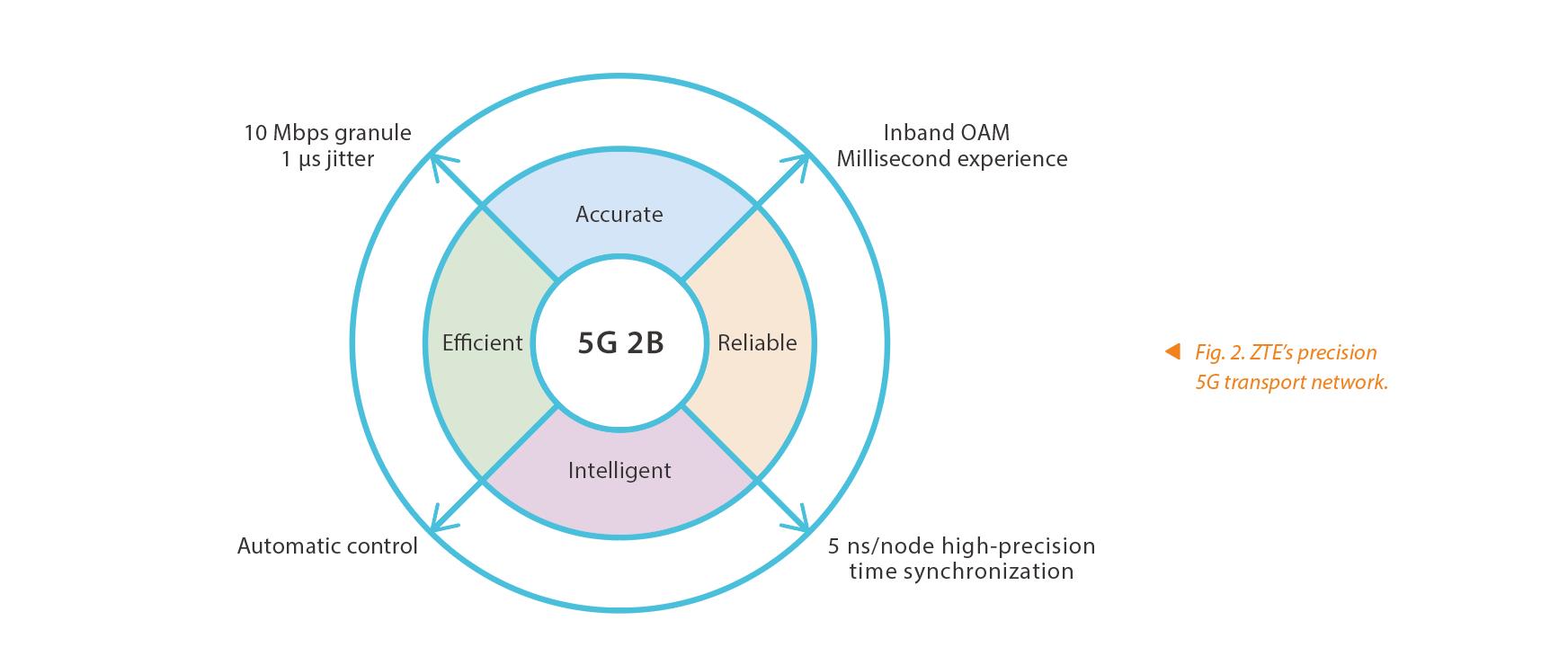Services drive network development. In order to meet the need of differentiated services in the 5G era, three major operators in China all conducted centralized procurement of 5G transport networks and started large-scale construction in the first half of 2020. More than 200,000 5G transport devices have been deployed in China, and China has built the world's largest 5G transport network. With the advancement of new infrastructure, 5G will inevitably drive operators to extend from ToC to ToB. To bring 5G into full play in various vertical industries, it is necessary to have a deeper understanding of 5G features and service requirements, and to continually make technological innovation.
Shift from ToC to ToB
Although 5G transport network aims at ToC at the first stage, 5G features make it destined to go beyond traditional human-to-human communication. GSMA predicts that 5G will generate $619 billion in revenue for operators in the ToB sector by 2026, accounting for 36% of total revenue. Among them, transportation and autonomous driving will bring $120 billion, accounting for 19%, while smart manufacturing $113 billion, 18% (Fig. 1). The integrated applications of 5G and vertical industries will become the key to future development.
In the R15 that was frozen in 2018, 3GPP studied and set standards for the enhanced mobile broadband (eMBB) scenario, made clear the forward-compatibility ultra reliable low latency communication (URLLC) and massive machine type communication (mMTC) scenarios, and worked out key network indicators in the vehicle-to-everything (V2X) and industrial control scenarios. The 5G performance defined by ITU contains a connection density of 106/km2, an air interface delay of 1 ms and a mobile speed of 500 km/h, which can be a good support to low-latency scenarios such as industrial & transportation automation and automatic driving, as well as to massive connection scenarios such as massive sensors and smart homes.
2020 witnessed the accelerated new infrastructure deployment and rapid 5G development. As the driver of new infrastructure, 5G is bound to shift operators from ToC to ToB and promote full integration with other technologies. Operators have coordinated efforts from multiple departments to constantly broaden and deepen 5G industry applications. Key research projects cover the fields of medical care and epidemic prevention, industrial internet, media and entertainment, and internet of vehicles, and a number of mature cases have emerged. It can be predicted that 5G applications in vertical industries will give rise to more emerging needs and services, and will continue to expand new areas for digital economy.

The R16 standard was frozen in July 2020, of which URLLC scenarios and features are the most important part. R16 enhances industry applications and defines the scenarios and technologies related to transport networks.
—R16 strengthens technical expansion and applications of time sensitive network (TSN), supports the integration of TSN and 5G, and can use 5G NR to replace the wireline network in the campus, making industrial production more flexible.
—In terms of traffic control, R16 uses the diameter overload indication conveyance (DOIC) mechanism similar to the Diameter protocol, carries traffic control information in HTTP messages, achieves active flow control between network elements, and reduces the risk of network congestion when sudden traffic occurs during peak hours.
—In terms of slicing, R16 connects the operator network and the enterprise-side authentication system, and allows enterprises to flexibly control the access through a secondary slice authentication. It can also select target AMF and V/I-SMF according to NSSAI during the handover from 4G to 5G to enable slice interoperability.
—R16 starts research into 5G-based V2X. Through 5G lower latency, higher reliability and larger capacity, R16 builds a communication network between vehicles and vehicles, vehicles and people, and vehicles and roadside infrastructure to enable information exchange.
Driven by network readiness, policy guidance and standards freezing, industry applications have developed from their infancy.
Technological Innovation to Meet Industry Needs
Traditional ToC businesses focus on bandwidth, while ToB businesses focus on end-to-end service experience such as latency, jitter, security and isolation. Different vertical industries or application scenarios have different requirements for network bandwidth, delay and other KPIs. Big videos need large bandwidth, low latency, as well as cloud-based content processing such as image splicing and encoding/decoding in MEC to reduce terminal weight, costs, network load and O&M pressure, and lower requirement for energy consumption and performance. Services like remote control and autonomous driving need low latency and high reliability. Smart grid needs low-cost, flexible, efficient, secure and reliable RAN transport as well as more automatic and controllable network management.
In the pre-research stage of 5G transport networks, industry applications have been brought into the key research to meet differentiated SLA requirements of vertical industries. The key technologies include SR, inband OAM, telemetry, FlexE, high-precision time synchronization, as well as centralized management and orchestration. With the expansion of 5G applications, transport technologies are evolving and improving.
To leverage the commercial value of 5G, telecom operators need to create new business models and new capabilities, which put forward new technical requirements. China Mobile has proposed a new service-oriented network model that contains preferential, exclusive and premium services. To match high-value users in the power and finance sectors, the slice granularity has been refined from 5 Gbps to 10 Mbps, which has led to technological innovation in small granules and hard-isolated slices, and accelerated the work of related technical specifications and verification. To facilitate enterprises to access the cloud, China Telecom and China Unicom have actively introduced SRv6 to bridge the gap between CT and IT. The operators have also actively introduced slicing and SD-WAN technologies to quickly offer different SLA services to enterprise users in different scenarios with the help of end-to-end service management and orchestration system.
With a deep insight into the challenges faced by operators in expanding the ToB market, ZTE has put forward the concept of precision 5G transport network. The concept integrates innovative technologies such as precise pipelines, precise management and control, precise diagnosis, and precise time, which can provide users with 10 Mbps hard slicing and lossless bandwidth adjustment, minute-level automatic slicing, millisecond-level service monitoring, and 5 ns single-node intelligent clock (Fig. 2).

The precision 5G transport network delivers precise pipelines on the forwarding plane to achieve deterministic forwarding, supports one-hop service transmission and physical-level security isolation, and provides infrastructure for on-demand slicing. It provides precise control on the management and control plane to match network resources with SLA services on demand, delivers exclusive resources and functions to industry users, and distributes slices automatically. After services are carried on demand, it implements precise diagnosis to offer immersive service experience and optimizes the network in real time to enable the closed-loop lifecycle service management. It provides precise time for ultra-high-precision synchronization and coordinates synchronization in smart factories while satisfying deterministic forwarding. It also differentiates protection services for power grid and supports indoor positioning based on synchronization.
The precision 5G transport network needs a complete coordination of clouds, networks, edges and terminals to create greater value for enterprise users, and also needs to strengthen the coordination with RAN and core network. This is exactly the advantages of ZTE as the world's leading provider of end-to-end products and solutions. ZTE continues to build and evolve end-to-end network capabilities based on the concept of automation, intelligence, complete convergence, and full-service. It uses the slicing technology to implement global resource scheduling, network-based resource orchestration, and end-to-end SLA guarantee, providing users with an end-to-end precision network. The precision network will help operators deploy 5G quickly, cope with the long-term development of vertical industries, and surpass rivals in the 5G IoE era.
Conclusion
With the deepening of industry needs and technical growth in future, the precision 5G transport network will have new connotations such as more accurate understanding of service requirements, accurate user experience and network coordination status, accurate network intent execution, and accurate QoS guarantee. These will be foreseeable development trends of the precise 5G transport network, and will ultimately lead to precise resource scheduling and O&M, precise network customization for extremely rich scenarios, and effective Opex reduction. The industry applications will surely be colorful in the upcoming years, and the ever-evolving precision 5G transport network will help operators embrace new services and create new value.